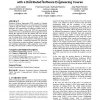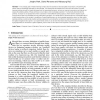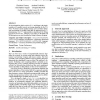1183 search results - page 6 / 237 » Patterns in Learning to Program - An Experiment |
ICSE
2008
IEEE-ACM
14 years 8 months ago
2008
IEEE-ACM
Distributed Software Engineering (DSE) concepts in Computer Science (or Engineering) Degrees are commonly introduced using a hands-on approach mainly consisting of teaching a part...
TLT
2010
13 years 6 months ago
2010
— A key design goal of mobile learning is that its built-in experiences are enjoyable and proactive, empowering the learner with the knowledge and ability to self-manage. This im...
ICFP
2008
ACM
14 years 7 months ago
2008
ACM
We investigated the relative merits of C++ and Erlang in the implementation of a parallel acoustic ray tracing algorithm for the U.S. Navy. We found a much smaller learning curve ...
ITICSE
2003
ACM
14 years 26 days ago
2003
ACM
There is now a substantial body of evidence in support of the use of pair programming in the classroom[3, 4, 10, 11, 13, 14]. Some of the data is anecdotal and some is the result ...
ISESE
2003
IEEE
14 years 26 days ago
2003
IEEE
Pair programming is a practice in which two programmers work collaboratively at one computer on the same design, algorithm, code, or test. Pair programming is becoming increasingl...



